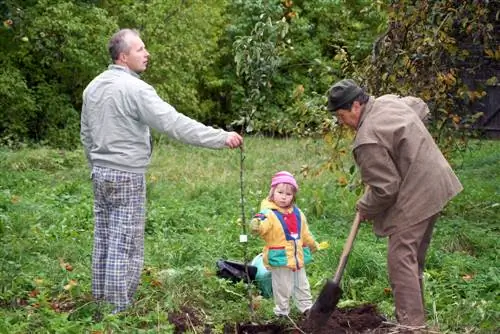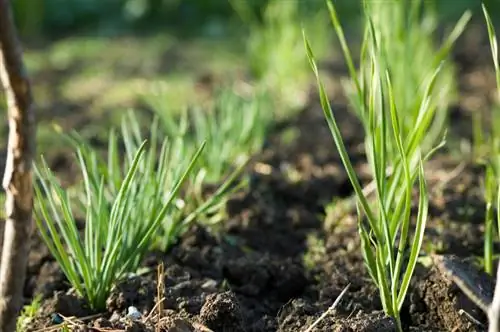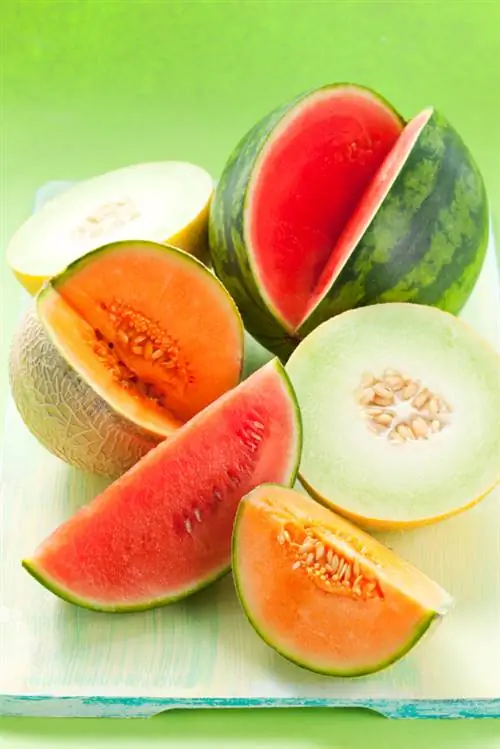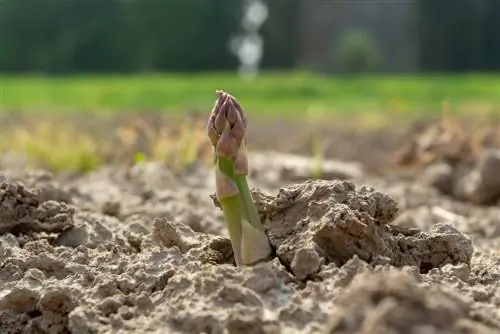- Author admin [email protected].
- Public 2023-12-16 16:46.
- Last modified 2025-06-01 06:02.
Is there anything more delicious than picking a crisp apple or a sweet pear from your own garden and eating it fresh from the tree? The selection of suitable fruit species and varieties is large - however, not every tree is suitable for every garden and important information should also be observed when planting. However, if the location, soil and other conditions are correct, nothing stands in the way of a rich harvest.
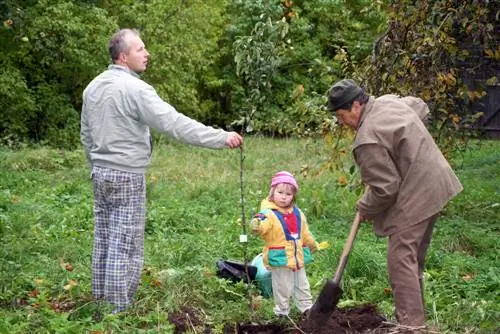
How to plant a fruit tree correctly?
To plant a fruit tree correctly, you should prepare the ground, dig a sufficiently large planting pit, insert the planting stake, plant the tree at the right depth, fill with soil, attach the tree to the stake, water and cover the tree disc. The optimal planting time is usually in autumn or early spring.
Which location is best for fruit trees?
Most types of fruit need a location in full sun so that their fruits can take on the color typical of the variety and develop their characteristic aroma. Some species still feel comfortable in light partial shade, as long as they still get several hours of direct sun there every day. For shady (but not completely dark!) locations, we recommend typical forest edge plants such as blackberries, raspberries, wild strawberries etc.
Which soil do fruit trees prefer?
No blanket statements can be made here, because every fruit tree prefers a different soil depending on the type and variety. Apples, pears and cherries prefer dry, well-drained soil, while plums also thrive in moist soil.
Planting a fruit tree correctly in the garden - this is how it works
When planting the fruit tree, the most important thing is that the soil is loosened well beforehand. If a larger number of trees are to be planted, it is recommended to take a soil sample. Based on the analysis, missing nutrients (especially phosphorus and potassium) can be specifically incorporated before planting in the form of stock fertilization. And this is how it is planted:
- First dig a planting pit.
- This should measure at least one meter by one meter square.
- If the ground is loose, dig a spade.
- If the ground is very firm, two sod cuts.
- Loose the bottom layer of soil with a digging fork.
- Mix the excavated material with mature compost.
- Now insert the plant stake.
- Now insert the tree.
- The processing point(s) must be neither in nor too close to the ground.
- Otherwise the base could form roots.
- Fill in the soil again and gently tamp it down.
- Tie the tree to the plant post in the shape of a figure eight using a sisal or coconut fiber rope (€6.00 on Amazon).
- Make a watering rim around the tree.
- Prune trees planted in autumn.
- Soak the tree well with several watering cans of water.
- Cover the tree disc with rotting manure, short straw or grass clippings.
- This keeps the moisture longer.
When is the best time to plant fruit trees?
Fruit trees should be planted in autumn if possible, but early spring is also a very suitable planting date.
What planting distance should be maintained?
Anyone who has just bought a small fruit tree from the nursery likes to plant it far too close to the other trees - however, the apple tree grows and can reach considerable dimensions depending on its growth habit. Below we have therefore listed the recommended planting distances for the most important types of fruit and growth forms that have proven themselves in home and allotment gardens.
| Fruit | Growth habit | Planting spacing |
|---|---|---|
| Apple | High/half trunk | 8 to 10 meters |
| bush tree | 3 to 4 meters | |
| Spindle tree (e.g. espalier) | 2 to 2.5 meters | |
| Pear | High/half trunk | 8 to 10 meters |
| bush tree | 4 to 5 meters | |
| Spindle tree | 2 to 2.5 meters | |
| Plum, plum, mirabelle plum, reindeer clode | Half / standard trunk | 5 to 6 meters |
| Sweet cherry | Half / standard trunk | 8 to 10 meters |
| Sour cherry | bush tree | 4 to 5 meters |
| Peach | bush tree | 4 to 5 meters |
| Apricot | Half trunk / bush tree | 4 to 5 meters |
| Quince | bush tree | 3 to 4 meters |
| Walnut | High trunk | 10 to 15 meters |
| Hazelnut | Shrub | 5 to 6 meters |
Be sure to maintain the planting distances, because well-lit crowns are one of the most important prerequisites for high-quality, sun-drenched fruit. In addition, diseases occur much more frequently in plantings that are too dense.
What are boundary distances and why are they so important?
The boundary distances are almost even more important than the planting distances. Time and again, neighborly relationships are marred by a tree or bush growing across the border. Although the specific regulations on this vary greatly in the individual federal states, this simple rule of thumb actually applies almost everywhere: the ideal limit distance is half a planting distance. This means that if you plant a plum tree, for example, you should maintain a distance of around three meters from the neighbor's fence - then it will also work with the neighbors.
Are there also fruit trees that are suitable for keeping in containers?
Most classic fruit trees such as apples, pears and the like can grow up to four meters or higher. Due to their size, they are not suitable for container cultivation. If, on the other hand, the fruit trees are grafted onto weakly growing rootstocks, they can also be kept in a sufficiently large pot. Columnar fruit is also very suitable.
Tip
Especially with spindle bushes and berry tree trunks, you should check the tree post from time to time and, if necessary, replace it if it is rotten.

